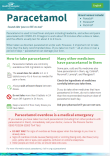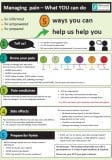Wishing everyone happy holidays and a joyful New Year from the Healthify team. Don't forget to Slip, Slop, Slap and Wrap!
Paracetamol
Sounds like 'par-ah-see-tah-mol'
Key points about paracetamol for adults
- When it's taken as directed, paracetamol works well for pain relief. However, it's important that you read and follow the instructions provided on the packaging carefully.
- Don't take more than the daily recommended dose. If you take too much, all at once or over a period of days, paracetamol can damage your liver.
- Be aware that some pain relief and cold and flu medicines have paracetamol in them.
- Find out how to take it safely and possible side effects.

Paracetamol is used to treat different types of mild to moderate pain including headache, migraine, period pain and aches and pains associated with colds and flu. It's the most commonly used pain relief medicine in Aotearoa New Zealand. Read more about medicines for short term pain.
Paracetamol is also used to treat fever but mild fever doesn't need to be treated unless it's causing discomfort.
Note: The information on this page is about paracetamol for adults. We also have a page on paracetamol for children.
Paracetamol tablets are available in 2 strengths
In Aotearoa New Zealand, paracetamol tablets are available in 2 strengths; 500 mg tablets and 665 mg tablets. Your dose of paracetamol will depend on the strength you're taking.
- 500 mg tablets and caplets: Panadol®, Pacimol®, Ethics Paracetamol®, Paracare Paracetamol®, Tylenol®.
- 665 mg tablets: Apo-Osteo®, Panadol Osteo®, Paracetamol Osteo-Tab®.
Paracetamol is also in some other medicines such as cold and flu medicines and in pain-relief medication (see below for examples).
Factsheet: How to take paracetamol

Paracetamol factsheet
Healthify He Puna Waiora, NZ, 2022
English [PDF, 144 KB], te reo Māori [PDF, 154 KB], Samoan [PDF, 132 KB], Cook Islands Māori [PDF, 731 KB], Tongan [PDF, 170 KB]
500 mg is the most common strength, available as tablets or caplets (tablets that are shaped like capsules). They are immediate-release tablets, meaning they start working straight away.
- Dose: The usual dose for adults is 1 or 2 tablets every 4 to 6 hours when required for pain or fever. Don't take more than 4 doses in 24 hours (8 tablets in 24 hours). Taking more than the recommended dose can harm your liver.
- Timing: Depending on why you're taking paracetamol, your healthcare provider may advise that you take regular doses or take it only when you need it for pain relief. Wait at least 4 hours between doses. Keep track of the timing of your doses and check when it was last taken before taking it again.
The 665 mg tablets are used for osteoarthritis. These are modified-release tablets, where the dose is delivered over a longer period of time. This means you take fewer doses throughout the day.
- Swallow the tablets whole: Don't crush or chew them.
- Dose: The usual dose for adults is 2 tablets every 6 to 8 hours when required for pain. Don't take more than 6 tablets in 24 hours. Taking more than the recommended dose can harm your liver.
- Timing: Depending on why you're taking paracetamol, your healthcare provider may advise that you take regular doses or take it only when you need it for pain relief. Wait at least 6 hours between doses. Keep track of the timing of your doses and check when it was last taken before taking it again.
Some people may need lower doses of paracetamol
Some people should take less than the usual dose, for example if:
- you have liver problems,
- you weigh less than 50 kg
- you drink a lot of alcohol
- you're dehydrated.
If one or more of these apply to you, the usual adult dose may be harmful to your liver. Talk to your pharmacist or healthcare provider if you don't know how much to take.
Taking paracetamol with other pain medicines
Paracetamol is also in many pain medicines you can buy from the pharmacy (eg, Maxigesic® and Nuromol®). An overdose can happen if you take another medicine that contains paracetamol at the same time.
If you do take other medicines that have paracetamol in them, be careful not to take more than the recommended dose of paracetamol each day (4 grams in 24 hours). If you're taking paracetamol 665 mg modified release tablets, don't take other products containing paracetamol.
It's safe to take paracetamol with other types of pain medicines that don't contain paracetamol (eg, ibuprofen) and opioid medicines (eg, codeine). Pain relief medicines all work differently so the type of medicine you need to treat your pain depends on the type of pain you have.
Paracetamol is found in many cold and flu products
Check the ingredients of cold and flu medicines before you take them. Paracetamol is included in many cold and flu products, such as Codral®, Coldrex® and Lemsip®.
If you do take other medicines that have paracetamol in them, be careful not to take more than the recommended dose of paracetamol each day (4 grams in 24 hours). If you're taking paracetamol 665 mg modified release tablets, don't take other products containing paracetamol.
Check with your pharmacist if you're not sure whether a product contains paracetamol.
Paracetamol is a very popular medicine and when taken correctly works well. However, too much paracetamol is very harmful to your liver.
If you realise you've had too much paracetamol (including from other products with paracetamol in them), call your healthcare provider or the Poisons Centre 0800 POISON (0800 764 766) immediately.
DO NOT wait for signs of an overdose as these appear later when the damage to your liver is already done.
Late signs may include:
- nausea (feeling sick) or vomiting (being sick)
- diarrhoea (runny poo)
- yellow skin or eyes
- poor appetite
- confusion or extreme sleepiness.
Older adults are most at risk, so should take extra care.
Brochures
Paracetamol factsheet [PDF, 144 KB] Healthify He Puna Waiora, NZ English [PDF, 144 KB], te reo Māori [PDF, 154 KB], Samoan [PDF, 132 KB], Cook Islands Māori [PDF, 731 KB], Tongan [PDF, 170 KB]
Paracetamol in te reo Māori(external link) My Medicines, NZ
Managing pain poster [PDF, 126 KB] Waitematā DHB, NZ
References
- Paracetamol(external link) New Zealand Formulary
- Paracetamol (Noumed)(external link) Medsafe datasheet, NZ
- Panadol Osteo(external link) Medsafe datasheet, NZ
- Modified-release paracetamol – Unpredictable in overdose(external link) Medsafe, NZ, 2019
- Proposed changes to paracetamol warning and advisory statements(external link) Medsafe, NZ, 2020
- Managing pain in osteoarthritis – focus on the person(external link) BPAC, NZ, 2018
- The principles of managing acute pain in primary care(external link) BPAC, NZ, 2018
Brochures

Healthify He Puna Waiora, NZ, 2022
Englishte reo Māori
Samoan
Cook Islands Māori
Tongan

My Medicines, NZ, 2023
Credits: Healthify editorial team. Healthify is brought to you by Health Navigator Charitable Trust.
Reviewed by: Stephanie Yee, Pharmacist, Auckland.
Last reviewed:






